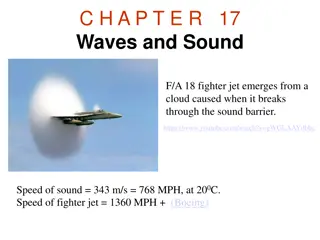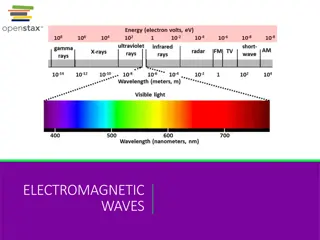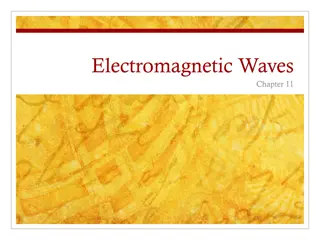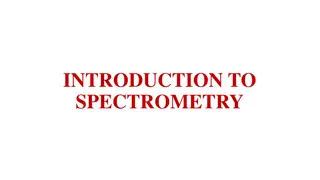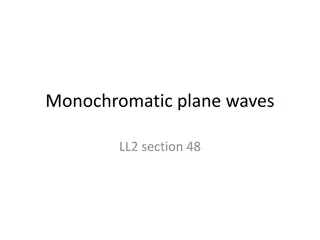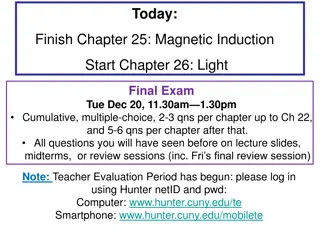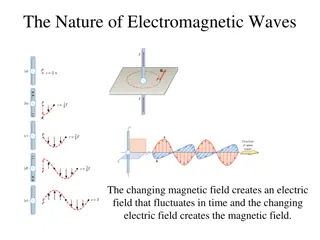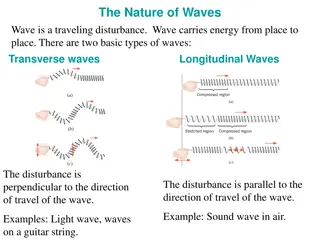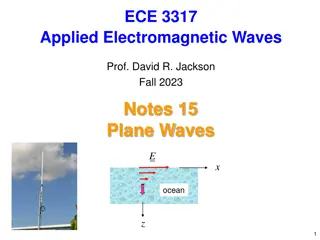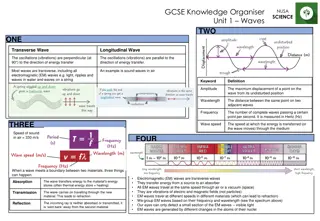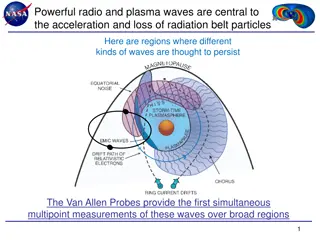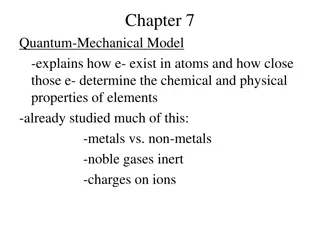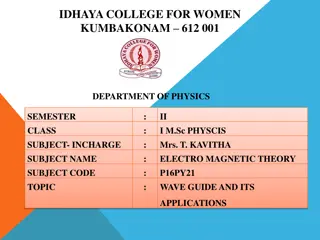Understanding General Plane Waves in Electromagnetic Theory
This study focuses on the analysis of general plane waves in electromagnetic theory, covering topics such as the general form of plane waves, Helmholtz equation, separation equation, wavenumber vector, Maxwell's equations for plane waves, and the symbolic representation of plane waves. The content delves into the mathematical expressions and properties of plane waves, providing insights into wavenumber equations, phase change, attenuation, and the relationships between electric and magnetic fields in wave propagation.
Download Presentation

Please find below an Image/Link to download the presentation.
The content on the website is provided AS IS for your information and personal use only. It may not be sold, licensed, or shared on other websites without obtaining consent from the author. Download presentation by click this link. If you encounter any issues during the download, it is possible that the publisher has removed the file from their server.
E N D
Presentation Transcript
ECE 6340 Intermediate EM Waves Fall 2016 Prof. David R. Jackson Dept. of ECE Notes 17 1
General Plane Waves = ( , , ) x y z ( , , ) E x y z E General form of plane wave: 0 j k x k y k z x + + ( ) ( , , ) x y z = The wavenumber terms may be complex. y z e where E k E + = 2 2 0 Helmholtz Eq.: ( ) ( ) ( ) 0 = 2 2 , , x y z , , x y z E E Property of vector Laplacian: 0 2 + = 2 0 E k E Hence 0 0 2 + = 2 0 k so 2
General Plane Waves (cont.) 2 + = 2 0 k This gives + k = 2 2 2 2 ( ) 0 k k k x y z or + = 2 2 2 2 k k k k + x y z (separation equation or wavenumber equation) 3
General Plane Waves (cont.) Denote = = + + xk yk zk k x y z + + xx x y xz r Then ( , , ) x y z = jk r e and k k k = 2 (wavenumber equation) Note: For complex k vectors, this is not the same as saying that the magnitude of the k vector is equal to k. 4
General Plane Waves (cont.) We can also write = k j Wavenumber vector so j r ( , , ) x y z = r e e The vector gives the direction of most rapid phase change (decrease). The vector gives the direction of most rapid attenuation. To illustrate, consider the phase of the plane wave: = = ( , , ) x y z r x y z x y z = = x y z ( , , ) x y z x y z = ( , , ) x y z Similarly, 5
General Plane Waves (cont.) A general plane wave: = jk r ( , , ) x y z e z S = k j = S ReS y 1 2 = * S E H x In the most general case, all three vectors may be in different directions. 6
General Plane Waves (cont.) Symbol for a plane wave: In the most general case, the k vector may be complex. In this case it is not possible to actually visualize it as vector in 3D space. The blue arrow is still used as a symbol for the k vector. z k y x 7
General Plane Waves (cont.) Next, look at Maxwell s equations for a plane wave: = = E j H H j E c + = + + x y z x y z = = + x y z ( ) ( ) ( ) jk jk jk x y z jk = jk Hence jk E = jk H = j H j E c 8
General Plane Waves (cont.) Summary of Maxwell s curl equations for a plane wave: k E = H = k H E c 9
General Plane Waves (cont.) Gauss law (divergence) equations: = = D 0 B v ( ) ( ) = 0 jk H = 0 jk E k H = 0 k E = 0 Reminder: The volume charge density is zero in the sinusoidal steady state for a homogeneous source-free region. 10
General Plane Waves (cont.) Furthermore, we have from Faraday s law k E = H Dot multiply both sides with E. E H = 0 ( ) k E = 0 ( , ) k E E for any vectors Note : 11
General Plane Waves (cont.) Summary of dot products: k E = 0 k H = 0 E H = 0 Note: If the dot product of two vectors is zero, we can say that the vectors are perpendicular for the case of real vectors. For complex vectors, we need a conjugate (which we don t have) to say that the vectors are orthogonal . 12
Power Flow 1 2 * = E H S 1 = H E j = E E 0 1 = jk E ( ) j 1 = k E 1 = ( ) k E 0 13
Power Flow (cont.) so 1 2 1 ( ) * = k E * S E 0 0 ( ) 1 2 * * 0 = E k E Note: is assumed to be real here. 0 2 ( ) ( ) B C = ( ) A B A C C A B Use ( ) ( ) ( ) * * 0 * 0 * * * 0 = E k E E E k E k E so that 0 0 0 ( ) ( ) 1 2 * 0 * * * 0 = S E E k E k E and hence 0 0 2 14
Power Flow (cont.) ( ) ( ) 1 2 * 0 * * * 0 = S E E k E k E 0 0 2 Assume E0= real vector. (The same conclusion holds if it is a real vector times a complex constant.) ( ) * ( ) * * * 0 = = = 0 E k E k E k (All of the components of the vector are in phase.) 0 0 Note: This conclusion also holds if k is real, or is a real vector times a complex constant. Hence 1 2 2 * = S E k 0 2 15
Power Flow (cont.) 1 2 2 * = S E k 0 2 = S ReS The power flow is: 1 2 2 = S Re E k so 0 2 (assuming that is real) = k j Recall: 16
Power Flow (cont.) Then 2 2 = S E 0 2 Power flows in the direction of . Assumption: Either the electric field vector or the wavenumber vector is a real vector times a complex constant. (This assumption is true for most of the common plane waves.) 17
Direction Angles = = direction of powerflow k z First assume k =real vector (so that we can visualize it) and the medium is lossless (k is real): k y x The direction angles ( ) are defined by: Note: = = = sin cos sin sin k k k k x + + 2 x 2 y 2 z k k k y = = + 2 2 2 2 sin cos k k cos k k 2 k z 18
Direction Angles (cont.) From the direction angle equations we have: zk k = cos k k y = tan x Even when (kx , ky , kz) become complex, and k is also complex, these equations are used to define the direction angles, which may be complex. 19
Homogeneous Plane Wave Definition of a homogenous (uniform) plane wave: ( ) are real angles In the general lossy case (complex k): = + + xk yk zk k x y z k x = sin cos + sin sin + y z cos = k r where sin cos + sin sin + r x y z cos r =real unit vector pointing in the direction of power flow 20
Homogeneous Plane Wave (cont.) Hence we have k r = = ( ) = k k jk r k r The phase and attenuation vectors point in the same direction. The amplitude and phase of the wave are both constant (uniform) in a plane perpendicular to the direction of propagation. Note: A simple plane wave of the form =exp(-j k z) is a special case, where = 0. z Note: = A homogeneous plane wave in a lossless medium has no vector: z k k y k r = = 0 x 21
Infinite Current Sheet z An infinite surface current sheet at z=0 launches a plane wave in free space. Plane wave y ( ) , s J x y x + ( ), j k x k y = real , J Ae k k x y Assume s x y + + = 2 x 2 y 2 z 2 0 k k k k The vertical wavenumber is then given by 22
Infinite Current Sheet (cont.) Part (a): Homogeneous plane wave = = 0.5 0.5 k k k k 0 0 x y 1 = = 2 0 2 0 2 0 0.25 0.25 zk k k k k 0 2 =+ 0.707 ( ) zk k outgoing wave We must choose 0 0 k k = + + y z (0.5) (0.5) (0.707) x Then z = = S k Power flow y 0 = + + y z (0.5) (0.5) (0.707) k x x = 0 23
Infinite Current Sheet (cont.) Part (b) Inhomogeneous plane wave = = 2 3 k k k k 0 0 x y = 2 0 2 0 2 0 4 9 zk k k k = 12 jk 0 The wave is evanescent in the z direction. = 0 12 zk jk We must choose k k = + + 0 y z (2) (3) ( 12) x j Then 0 = + + = y z (2) (3) (0) 0 ( 12) z k x k 24
Infinite Current Sheet (cont.) z 0 = + y (2) (3) k x Power flow = 0 ( 12) z k (in xy plane) y x zk k = S = = k cos 12 j 3 2 0 = = y tan so x so = + (1.956) [rad] j 2 = 56.31 Note: Another possible solution is the negative of the above angle. The inverse cosine should be chosen so that sin is correct (to give the correct kx and ky ): sin > 0. 25
Propagation Circle + + = 2 x 2 y 2 z 2 0 ) Propagating waves: k k k k + 2 x 2 y = 2 0 k k k ky ( = + 2 z 2 0 2 x 2 y k k k k ( ) k so real z k0 kx Evanescent Propagating (outside circle) (inside circle) = + 2 x 2 y 2 0 k j k k k z = 2 2 2 k k k k 0 z x y Free space acts as a low-pass filter. 26
Radiation from Waveguide z PEC y WG Ey x = ( , ,0) E x y cos y a y b x a 27
Radiation from Waveguide (cont.) Fourier transform pair: = + + ( ) j k x k y ( , , ) ( , , ) E x y z e E k k z dxdy x y y x y y 1 + ( ) j k x k y = ( , , ) E x y z ( , , ) E k k z e dk dk x y y y x y x y 2 (2 ) 28
Radiation from Waveguide (cont.) 1 + ( ) j k x k y = ( , , ) E x y z ( , , ) E k k z e dk dk x y y y x y x y 2 (2 ) + = 2 2 0 E k E y y 2 2 2 E x E y E z y y y + + + = 2 0 k E y 2 2 2 Hence 2 E z 1 + ( ) j k x k y + + = y 2 x 2 y 2 0 k E k E k E e dk dk x y y y y x y 2 2 (2 ) 29
Radiation from Waveguide (cont.) Hence 2 E z + + = y 2 x 2 y 2 0 k E k E k E y y y 2 Next, define 2 z 2 2 x 2 y k k k k We then have 2 E z + = y 2 z 0 k E y 2 30
Radiation from Waveguide (cont.) Solution: e = jk z Note: We want outgoing waves only. ( , , ) ( , ,0) E k k z E k k z y x y y x y Hence 1 j k x k y k z + + ( ) = ( , , ) E x y z ( , ,0) E k k e dk dk x y z y y x y x y 2 (2 ) + 2 x 2 y 2 0 k k k (Homogeneous) Power flow y + 2 x 2 y 2 0 k k k (Inhomogeneous) 31
Radiation from Waveguide (cont.) Fourier transform of aperture field: + + ( ) j k x k y = ( , ,0) ( , ,0) E x y E k k e dxdy x y y x y y /2 /2 b a x + + ( ) j k x k y = cos e dxdy x y a /2 /2 b a /2 /2 a b x + ( ) j k y + = ( ) j k x cos e dx e dy y x a /2 /2 a b a a cos k k b x 2 2 y = ( , ,0) sinc b E k k y x y 2 2 2 k a x 2 2 32
Radiation from Waveguide (cont.) Note: e = = jk z ( , , ) ( , ,0) 0 E k k z E k k z x x y x x y Hence ( , , ) E x y z = 0 x For Ezwe have E y E z y + = = 0 z 0 E ( ) This follows from the mathematical form of Ey as an inverse transform. ( ) + = 0 jk E jk E y y z z 33
Radiation from Waveguide (cont.) Hence k k y = E E z y z In the space domain, we have k k 1 j k x k y k z + + ( ) y = ( , , ) E x y z ( , ,0) E k k e dk dk x y z z y x y x y 2 (2 ) z 34
Radiation from Waveguide (cont.) z Summary (for z > 0) PEC y ( , , ) E x y z = WG 0 Ey x 1 j k x k y k z + + ( ) = ( , , ) E x y z ( , ,0) E k k e dk dk x y z y y x y x y 2 (2 ) k k 1 j k x k y k z + + ( ) y = ( , , ) E x y z ( , ,0) E k k e dk dk x y z z y x y x y 2 (2 ) z a a cos k k b x 2 2 y = ( , ,0) sinc b E k k y x y 2 2 2 k a x 2 2 35
Some Plane-Wave Theorems Theorem #1 E E = H H 2 (always true) Theorem #2 If PW is homogeneous: 2 2 2 = E H (lossy medium) 2 2 = 2 E H (lossless medium) Theorem #3 If medium is lossless: = 0 36
Example Example j k x k y k z + + ( ) = = ( , , ) x y z ye y E x y z Plane wave in free space Given: Note: It can be seen that = = 2 0 k k k 0 x + = 2 x 2 y 2 z 2 0 k k k k + y and = 3 k j k k E = 0 0 z Find H and compare its magnitude with that of E. Verify theorems 1 and 3. 37
Example (cont.) = E j H 0 so jk E = j H 0 1 = k E H 0 k = (0,1,0) ( , , ) (2,0, 3) 0 j x y z 0 38
Example (cont.) 1 = + x j z [ (2) ( 3)] H 0 2 2 * = H H = + = + * x * z H H H H H H H x z x z 1 7 2 = + = 2 2 3 H j 0 0 Hence E H = 0 7 Note: The field magnitudes are not related by 0! 39
Example (cont.) E E = H H 2 0 Verify: (Theorem #1) = ( , , ) x y z y E 1 ( ) = + x j z [ (2) ( 3)] , , x y z H 0 At the origin ( = 1) we have: E E = 1 1 1 1 ( ) H H = + 3)] [ (2) + = 4 3 = x j x j z z [ (2) ( ( 3)] 2 0 2 0 2 0 40
Example (cont.) = 0 Verify: (Theorem #3) ( ) k ( ) = = x Re 2 k 0 ( ) ( ) k = = z Im 3 k 0 = = 2 0 k k k 0 x Hence y = 0 = 3 k j k 0 z 41



